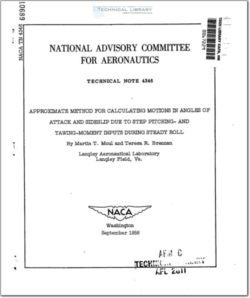NACA-TN-4346

- Version
- 135 Downloads
- 924.39 KB File Size
- 1 File Count
- March 24, 2016 Create Date
- March 24, 2016 Last Updated
National Advisory Committee for Aeronautics, Technical Notes - Approximate Method for Calculating Motions in Angles of Attack and Sideslip Due to Step Pitching- and Yawing-Moment Inputs During Steady Roll

The simplified method of NASA Report 134% for calculating motions
in angles of attack and sideslip resulting from a trim angle of attack
and steady rolling velocity has been extended in the present paper to
the condition of pitching- and yawing-moment inputs. The resulting
formulas are intended primarily for rolling—velocity conditions in
which rolling divergence is not encountered. From the calculated angles
of attack and sideslip, preliminary estimates of aircraft loads for
design purposes can be made. Motions calculated with the simplified
method are compared with exact solutions of the five-degree-of-freedom
equations.
Many high-performance aircraft encounter inertia coupling in
rolling maneuvers. As a result this condition must be investigated
during the design of new aircraft. A thorough analysis of rolling flight
requires the solution of the nonlinear equations of motion, and analog
or digital computers are usually utilized for this problem. However,
for preliminary design purposes, simplified methods of analysis are
desirable.
A simplification used by many investigators in analyses of roll—
coupled motions is that of linearizing the equations of motion by
assuming rolling velocity to be constant. In early investigations of
the stability of steady—rolling aircraft (refs. 1 and 2), the concept
of critical rolling velocities was defined. Steady-state solutions of
these linearized equations also yield useful results as to the magni-
tudes of the responses to be expected in rolling maneuvers and have
been discussed in references 2 and 5. Transient solutions of the
equations of motion for steady rolling can be obtained, but such
calculations are lengthy. Approximate expressions presented in refer-
ence h permit simple calculation of transient responses of angles of
attack and sideslip due to a trim angle of attack.
In this paper the method of reference h is extended to the cal—
culation of motions resulting from step pitching—.and yawing—moment
inputs. This method is applicable to inputs such as elevator deflec-
tion, rudder deflection, aileron yaw, and yawing moment due to rolling
velocity. Transient responses of angles-of attack and sideslip are
presented for a range of rolling velocities for a current swept—wing
fighter airplane assumed to be flying at a Mach number of 0.7 and an alti-
tude of 52,000 feet. The method is intended primarily for conditions
of rolling velocities up to the critical value.
| File | Action |
|---|---|
| naca-tn-4346 Approximate Method for Calculating Motions in Angles of Attack and Sideslip Due to Step Pitching- and Yawing-Moment Inputs During Steady Roll.pdf | Download |
Comment On This Post